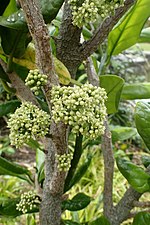Pennantia baylisiana
| Pennantia baylisiana | |
|---|---|

| |
| Scientific classification | |
| Kingdom: | Plantae |
| Clade: | Tracheophytes |
| Clade: | Angiosperms |
| Clade: | Eudicots |
| Clade: | Asterids |
| Order: | Apiales |
| Family: | Pennantiaceae |
| Genus: | Pennantia |
| Species: | P. baylisiana
|
| Binomial name | |
| Pennantia baylisiana (W. Oliver) Baylis
| |
Pennantia baylisiana, commonly known as Three Kings Kaikōmako and Kaikōmako Manawa Tāwhi (Māori) is a species of plant in the family Pennantiaceae (Icacinaceae in older classifications). It is endemic to the Three Kings Islands, New Zealand, where only one plant is known to exist. It is threatened by habitat loss.[1][3] Since its discovery in 1945; it has been successfully propagated.[4] The single tree known in the wild grows on a scree slope on the northern face of Great Island in the Three Kings group off Cape Reinga, New Zealand.[5] The species was discovered in 1945 by Professor Geoff Baylis of the University of Otago.
Description[]
Pennantia baylisiana is a multi-trunked tree which grows to a height of 5 m in the wild, though has been recorded reaching 8 m in cultivation. It has greyish-brown bark and brachlets that are covered with lenticels. It has leathery, green, egg-shaped 12 - 16 by 7 - 10 cm leaves that have hair covered domatium in their lateral veins and are suspended off of 2.5cm long petioles. Flowering occurs from October to November, producing 1.5 by 1.5 mm greenish-white flowers in terminal panicles with 2.6 mm petals. The stamen is made up of a 1 - 1.4 mm long anther on top of a 1.5 mm long filament, though the pollen is usually sterile. It has a 2.8 by 2 mm cylindrical ovary with a stigmatic ring 1.5 - 1.8 mm in diameter. Fruiting is from January through to April, yielding 10 by 4.5 mm ellipsoid fruit. Mature fruit are purple and have a 9 by 3.5 mm stone.[6][7]

Foliage

Flowers unfurling
Distribution[]
It is found only in the Three Kings Islands, an Island chain 55km north-west of the top of the North Island, on Great Island. There is only one tree known in the wild; a female growing above a cliff on the northern face of Great Island. [5][6][7][8]
Taxonomy[]
Pennantia baylisiana was first discovered by botanist Geoff Baylis in 1945 when he visited Great Island on a botanical expedition.[9]
Etymology[]
Pennantia is after Thomas Pennant a welsh zoologist and author from the 18th century. The specific epithet baylisiana recognises the 20th century New Zealand botanist Geoff Baylis.[7]
References[]
- ^ a b de Lange, P. (2014). "Pennantia baylisiana". IUCN Red List of Threatened Species. 2014: e.T30481A62768931. doi:10.2305/IUCN.UK.2014-2.RLTS.T30481A62768931.en. Retrieved 15 November 2021.
- ^ "Assessment Details for Pennantia baylisiana (W.R.B.Oliv.) G.T.S.Baylis". NZTCS. 2017. Retrieved 2021-08-24.
{{cite web}}: CS1 maint: url-status (link) - ^ "Kaikōmako manawa tāwhi (Pennantia baylisiana) returned to iwi". Manaaki Whenua. Retrieved 2021-04-23.
- ^ Renwick, Dustin (24 December 2019). "The story of the world's loneliest tree". National Geographic.
- ^ a b "World's rarest tree comes home to the Far North". Northern Advocate. 2019-08-25. ISSN 1170-0777. Retrieved 2019-09-03.
- ^ a b "Pennantia baylisiana". New Zealand Plant Conservation Network. Retrieved 2021-04-23.
- ^ a b c Eagle, Audrey Lily (2006). Eagle's complete trees and shrubs of New Zealand. Audrey Lily Eagle, Audrey Lily Eagle. Wellington, N.Z.: Te Papa Press. p. 420. ISBN 978-0-909010-08-9. OCLC 85262201.
- ^ "Table 3: Area (in 100 km2) of data contributions per country and within protected areas". dx.doi.org. doi:10.7717/peerj.4096/table-3. Retrieved 2021-04-23.
- ^ "Pennantia baylisiana - The University of Auckland". www.nzplants.auckland.ac.nz. Retrieved 2021-04-23.
External links[]
- World's rarest tree gets some help, John Platt, 20 April 2010, Scientific American
- NZ’s rarest tree back from the brink at Science Learning, University of Waikato
- IUCN Red List critically endangered species
- Pennantiaceae
- Flora of the North Island
- Critically endangered plants
- Three Kings Islands
- Endlings



